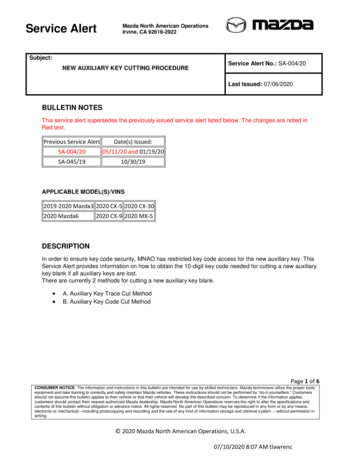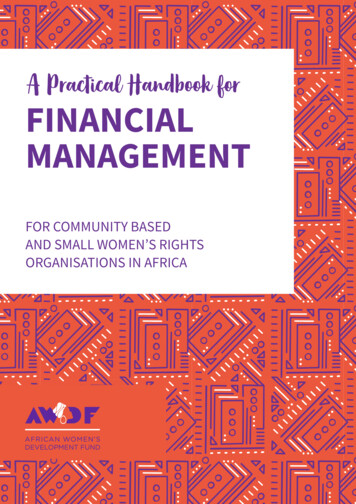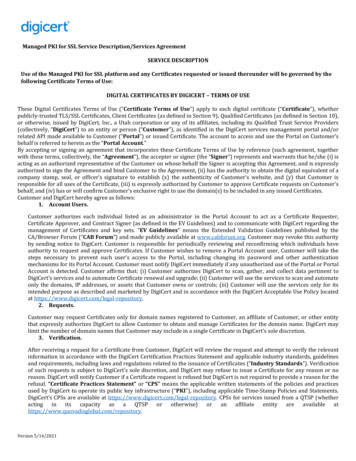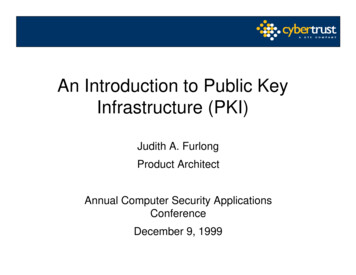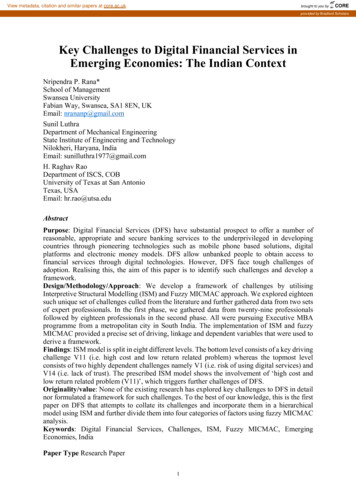
Transcription
View metadata, citation and similar papers at core.ac.ukbrought to you byCOREprovided by Bradford ScholarsKey Challenges to Digital Financial Services inEmerging Economies: The Indian ContextNripendra P. Rana*School of ManagementSwansea UniversityFabian Way, Swansea, SA1 8EN, UKEmail: nrananp@gmail.comSunil LuthraDepartment of Mechanical EngineeringState Institute of Engineering and TechnologyNilokheri, Haryana, IndiaEmail: sunilluthra1977@gmail.comH. Raghav RaoDepartment of ISCS, COBUniversity of Texas at San AntonioTexas, USAEmail: hr.rao@utsa.eduAbstractPurpose: Digital Financial Services (DFS) have substantial prospect to offer a number ofreasonable, appropriate and secure banking services to the underprivileged in developingcountries through pioneering technologies such as mobile phone based solutions, digitalplatforms and electronic money models. DFS allow unbanked people to obtain access tofinancial services through digital technologies. However, DFS face tough challenges ofadoption. Realising this, the aim of this paper is to identify such challenges and develop aframework.Design/Methodology/Approach: We develop a framework of challenges by utilisingInterpretive Structural Modelling (ISM) and Fuzzy MICMAC approach. We explored eighteensuch unique set of challenges culled from the literature and further gathered data from two setsof expert professionals. In the first phase, we gathered data from twenty-nine professionalsfollowed by eighteen professionals in the second phase. All were pursuing Executive MBAprogramme from a metropolitan city in South India. The implementation of ISM and fuzzyMICMAC provided a precise set of driving, linkage and dependent variables that were used toderive a framework.Findings: ISM model is split in eight different levels. The bottom level consists of a key drivingchallenge V11 (i.e. high cost and low return related problem) whereas the topmost levelconsists of two highly dependent challenges namely V1 (i.e. risk of using digital services) andV14 (i.e. lack of trust). The prescribed ISM model shows the involvement of ‘high cost andlow return related problem (V11)’, which triggers further challenges of DFS.Originality/value: None of the existing research has explored key challenges to DFS in detailnor formulated a framework for such challenges. To the best of our knowledge, this is the firstpaper on DFS that attempts to collate its challenges and incorporate them in a hierarchicalmodel using ISM and further divide them into four categories of factors using fuzzy MICMACanalysis.Keywords: Digital Financial Services, Challenges, ISM, Fuzzy MICMAC, EmergingEconomies, IndiaPaper Type Research Paper1
1. IntroductionDigital financial services (DFS) are the significant financial resolutions for cultivating financialinclusion (Buckley and Malady, 2015). DFS provides services to the underprivileged usingadvanced skills, digital platforms and electronic money models (Scott et al., 2017; David-Westet al., 2018). Digital channels can allow cost to be considerably low for both customers andservice providers through use by isolated and underserved residents (Baker et al., 2007; Alamand Imran, 2015; Lloyds et al., 2016; Tarhini et al., 2016; AFI Global, 2017; Thorseng andGrisot, 2017). Adoption and use of digital technologies allows millions of people to move outof the poverty every year (Gates Foundation, 2017). However, a vast majority of the worldpopulation fall into poverty due to various issues such as health, finance and otherastonishments. A number of those people living in or near the poverty line lack even the mostelementary banking services.The statistics specifies that only 16% of the population living on daily wages of lower than 2have formal bank accounts. The situation for women and those who live in rural areas is evenworse. According to Global Financial Inclusion database of World Bank, 2.5 billion peopleacross the world do not have their accounts in any financial institution. This makes it difficultfor them to make any financial transactions using electronic media. For this reason, the mostdisadvantaged households operate almost entirely with cash even today. As a result, suchpopulation entirely depends on cash, assets and informal money-lenders to meet their everydayfinancial requirements (Gates Foundation, 2017).1.1 Research MotivationsPer the annual Measuring the Information Society Report (2017), subscription to the mobilecellular networks extends to the majority of the population of the world, and 95% of the world’spopulation reside in areas covered through mobile phone signals. While 47% of the world’spopulation had online internet access by 2016, the remaining part of the population are stilldeprived of connectivity. The motivation behind introducing DFS is to mitigate the ongoingproblem of under-banked and unbanked population of the society to ensure that they activelyparticipate with the financial sectors in the developing and emerging market economies (DavidWest et al., 2018).The mobile phone has become the most favoured mode not only for communication but alsofor digital financial activities. However, there is still a lack of payment through mobile walletsin the developing world (Buckley and Mas, 2016; Tarhini et al., 2016; Ashraf et al., 2017; Patilet al., 2017; Asongu and Nwachukwu, 2018; Sharma et al., 2018). For example, in India, 60%of its 1.2 billion population are under-banked despite the fact that 75% of the overall population2
possess mobile phones. Like other emerging economies, around 67% Indians trust in cashtransactions. The statistics also indicate that only 10% of the country’s population make use ofdebit/credit cards while the rest rely on informal channels like Hawalas (transferring moneywithout money movement) (Amarante Consulting Group, 2014). Low penetration of DFS inthe country gives rise to some basic questions, which we have attempted to answer through thisresearch as follows:RQ1: What are current key challenges that inhibit growth of DFS in emerging economies,specifically India?RQ2: Are these key challenges interrelated? If yes, what kind of relationships exists?RQ3: Can these challenges be classified into major groups for their ease of removal?RQ4: Does there exist any framework of key challenges that can be used to improve andenhance DFS and make it more sustainable?Manyika et al. (2016) found that Indians lose more than 2 billion every year in inevitableincome simply because it takes time for money to travel from a bank to the other locations. Insuch scenarios, the innovative technologies of DFS offer an avenue for saving potential timeand gaining efficiency of financial services delivery at low expense, particularly to theunderprivileged section of society. In 2020, mobile phones are estimated to serve around 250million people. However, there are still a number of challenges, which need to be overcome(Amarante Consulting Group, 2014; Srivastava and Sharma, 2017). This research study willclassify and analyse numerous critical challenges pertaining to DFS and develop a frameworkusing them.Considering the above discussion, the following objectives are set for this study: [i] Recognisethe key challenges that inhibit DFS growth in India; [ii] Assess the interrelationships betweenkey challenges identified through literature review and cluster challenges into variouscategories and their similarity among them. [iii] Build a framework of identified challenges toefficiently utilize DFS in the country.Interpretive Structural Modelling (ISM) and fuzzy MICMAC are considered as suitableapproaches to: [i] discover links between the designated challenges; [ii] classify them as pertheir interrelation linkages, [iii] build a structural model (Sindhu et al., 2016). The developedstructural model could guide practitioners, governmental bodies and policymakers in removingkey challenges to DFS in emerging economies. The extension of fuzzy MICMAC over thetraditional MICMAC approach with ISM would allow managers not only to excerpt any unseenlinks between challenges, but also highlight the strengths of relationships between them (Luthraand Mangla, 2018).3
The remaining sections of the paper are structured as follows – the next section highlights theprior literature on DFS and identifies research gaps. Further, Section 3 explains themethodology used in this paper. Subsequently, findings of this work are provided in Section 4i.e. Data Analysis and Results. Section 5 discusses findings with managerial/practicalimplications. Finally, the paper concludes with future research directions in Section 6.2. Prior ResearchThis section contains the literature on DFS, current account of DFS in Indian context andidentification of major challenges of DFS in the country. Research gaps are also used tohighlight a theoretical lens that underpins the study.2.1 Digital Financial ServicesFinancial services for the underprivileged have experienced a transformation over the lastdecade. The developments in technology have resulted in the evolution of new business modelsand the potential to make DFS at the heart of financial transformation in future (Mattern andMcKay, 2018). DFS constitutes of a wide variety of advanced technologies such as mobilephone enabled solutions and structured electronic payment platforms (David-West et al., 2018).In other words, DFS are a vast range of services that are retrieved and delivered using digitalchannels such as credits, payments, savings, insurance etc. These range of services are enabledby devices such as electronic cards, chips, tablets, phablets, biometric devices and any otherelectronic system (AFI Global, 2016). DFS offer more flexibility for its customers in retrievingfinancial services. In less-developed nations, DFS can increase the percentage of the peopletaking part in the financial services systems, specifically among customers from rural areaswho have not experienced access of financial/banking services in the past (Finau et al., 2016).The literature shows that customers in less developed and developing countries often preventor discourage use of DFS (including mobile phone based solutions, digital payment platformsand electronic money models). For example, Lauer and Lyman (2015) considered risks of usingdigital services through mobile based banking, electronic money or digital payment platformsby the digitally excluded or underserved population as one of the challenges for DFS. Fatima(2011) found safety and reliability issues, privacy issues and week or poor authenticationprocess as other three challenges of DFS. Harsh and Wright (2016) discuss other challengesincluding lack of awareness, limited knowledge about the benefits of DFS, lack of digitalliteracy and issues related to technology and networking. Similarly, other issues include lackof training and skills to agents and mobile network operators (MNOs), legal and regulatoryissues (Chauhan, 2015), lack of keeping pace with new technologies (Holley, 2015), high cost4
and low return related issue (Microsave, 2016), universal unavailability of Internet (Wright etal., 2013), failure to reach out to the large majority of consumers, lack of greater integrationand interoperability, lack of trust, problem of dormancy, inability to transact in low value andgender disparities in mobile ownership (Briggs, 2016).2.2 Current Status of DFS in IndiaWhereas around 8-10% of the households in the UK, 10-15% in the USA and 7-10% in Francedo not have their bank accounts, the situation in developing nations is far more critical wherea sizable number (i.e. 25-65%) of households are disadvantaged because of not having basicaccounts in banks (Sundaram and Sriram, 2016). In India, Prime Minister Narendra Modilaunched the digitization system on the July 1st, 2015. The key purpose of this program was toensure the online connectivity for people living in rural areas by supporting them with highspeed network connectivity. The government has also been developing an efficient structure ofunified payment to offer speedy and secure transfer of services to relevant recipients (Rani,2016). The Intermedia Financial Inclusion Insight (FII) survey of 45,000 Indian adultsconducted in 2014 indicated that only 0.3% of adults in India use mobile money (Kumar, 2015).Hence, there is an enormous scope of using innovative technologies for DFS (Ahluwalia andBhatti, 2017). Currently, DFS are not prevalent in India because of a range of key challengessuch as inadequate infrastructure, lack of trust, lack of knowledge and additional cost involvedetc. (Dwivedi et al., 2016). Key challenges of DFS in emerging economies have been discussedin the next section.2.3 Key Challenges of DFS in Emerging EconomiesFor identifying the key challenges, we explored the literature through keywords such asinhibitors, barriers and hurdles that suppress growth of DFS in developing countries. We useddatabases such as Science Direct, Scopus and search engines like Google and Google Scholarto search for published journals, conference proceedings, reports and books. We found a totalof 106 papers out of which 49 were found to meet our criteria for this research. With help ofcomprehensive literature review, 18 key challenges of DFS were chosen (see Table 1). Thesechallenges were further authenticated through inputs received from experts (see Section 4).Table 1. Major DFS challengesV#ChallengeV1Risk of using digital servicesV2Safety and reliability issuesBrief descriptionSecurity and privacy risks for digitalservices like mobile banking can stopindividuals from using DFSConsumer engagement of using DFSwill reduce with security gaps andnonexistence of defence against5ReferencesLeeflang et al. (2014); Lauerand Lyman (2015); Gupta etal. (2017); Scott et al.(2017); David-West et al.(2018)Fatima (2011); Kumar andGoyal (2016); Tarhini et al.(2016); Gupta (2017); Ranaet al. (2018)
V3Privacy issuesV4Weak or poor authenticationprocessV5Lack of digital literacyV6Lessinformationadvantages of DFSaboutV7Technology and workOperators (MNOs)V9Legal and regulatory issuesV10Lack of adaptably of newtechnologiesV11High cost and low returnrelated reachabilityconsumersmassV14Lack of trustV15Lack of wider integration andinteroperabilityfraudulence and cyberattacks in theDFSConsumer trust and engagement forusing DFS will reduce with aninterventionofprivateandconfidential informationConsumer intention to use DFS willreduce with weak or poorauthentication process of digitalservicesConsumer can be discouraged fromusing DFS with lack of digital literacyConsumer intention of using DFS butthey do have proper informationabout advantages of DFSConsumers/MobileNetworkOperators (MNOs) trust toward DFSwill lower by facing the critical issuessuch as digital disruptionsLack of designing the right type ofagent training and skills developmentprogram to keep agents updated withinformation required to serve theconsumers can reduce agents’intention to effectively run the digitalfinancial services programLack of legal and regulatoryframework or guidelines for digitalservicesincreasesrisksanddiscourages consumer to effectivelyuse digital financial servicesBanking systems are negativelyinfluenced toward fostering DFS withthe Lack of adaptably of newtechnologies.High costs attached with small returnshave led digital services anunattractivepropositionforcommercial banks and profit-makingentities toward successfully rollingout the digital financial servicesLack of physical network to provideonline services to every part of thecountry could be a substantialchallenge, which can adverselyinfluence the significant use of DFSConsumer can be deprived of usingDFS if they have a lack of any type ofonlinepaymentarrangementincluding mobile money to reachfrom nowhere to the critical massLack of trust can stop consumer fromavailing the benefits of chbanking for both urban and rural6Fatima (2011); Weill andWoerner (2015); Castle et al.(2016); Athey et al. (2017);Rana et al. (2018)Fatima (2011); Karlan et al.(2016); David-West et al.(2018)Dwivedi et al. (2016); Harshand Wright (2016); Khokhar(2016); Gabor and Brooks(2017); Nedungadi et al.(2018); Rana et al. (2018)Harsh and Wright (2016);Lloyd et al. (2016);Siddiquee (2016); Gupta etal. (2017); Nedungadi et al.(2018); Rana et al. (2018)Au and Kauffman (2008);Harsh and Wright (2016);Scott et al. (2017); Rana etal. (2018)Chauhan (2015); Kanobe etal. (2017); Nesse et n (2015); Scott et al.(2017); David-West et al.(2018)Fitzgerald et al. (2014);Holley (2015); Scott et al.(2017); Das et al. (2018);Rana et al. (2018)Leeflang et al. (2014);Microsave (2016)Wright et al. (2013); Rana etal. (2018)Chauhan (2015); Lauer andLyman (2015); West (2015);Deichmann et al. (2016);Foster (2016); Rana et al.(2018)Lifen Zhao et al. (2010);Leeflang et al. (2014);Shareef et al. (2018)Wright et al. (2013);BourreauandValletti
V16Problem of dormancyV17Inability to transact in lowvalueV18Gender disparities in mobileownershipconsumers can reduce the pace ofDFS offered to consumersThe issue related to non-use of mobileand other digital services by theregisteredactivemobile/digitalservice users could reduce theeffectiveandsuccessfulimplementation of DFSIncompetence to hold enormouscapacity of small value exchanges atlow cost can reduce the effectivenessof using digital financial servicesReduced access for women of themobile smart phones decreases theirutilization of DFS(2015); David-West et al.(2018)Angelow et al. (2016);Mazer and Rowan (2016);Chandrasekhar and Ghosh(2018)Kendall et al (2011);Buckley (2015); Karlan etal. (2016); Gomber et al.(2018)Asongu (2015); Santosham(2015); Adam et al. (2018);Sinha (2018)2.4 Research GapsAs a critical indicator of economic health in India, DFS permit users to protect againstpredictable and unforeseen events, allowing industrialists and traders to capitalise on fresh andcreative dealings and to handle their supply chains, and make it possible for people, industries,financial-services providers and governments to control transactions proficiently (Scott et al.,2017; David-West et al., 2018). However, same amount of access of financial services is notenjoyed by individuals and businesses in emerging economies in comparison to theirequivalents in developed economies. As many as 45% or two billion individuals in theemerging economies’ adult population do not have their bank accounts or any kind of mobilemoney services. In addition, half of all such businesses in developing economies lack adequateaccess to the services they need to prosper (Dara, 2018).DFS studies and reports are primarily centred on African countries such as Kenya where mobiletechnology is pervasive (Haider, 2018). However, very little focus has been given to othercountries (e.g. Setia et al., 2013; Buckley and Malady, 2015; Aaluri et al., 2016; Finau et al.,2016). These studies have broadly brushed through DFS in general and there has not been anycomprehensive research on DFS that has been undertaken in the context of India (Srivastavaand Sharma, 2017). The current paper addresses that gap by assessing and analysing differentcritical challenges that constrain the growth of DFS in India.3. Research MethodologyInterpretive Structural Modelling (ISM) is a systematic and collaborative approach forscrutinising interlinks between factors (Warfield, 1974). It helps researchers to build structurala model among factors based on experts’ inputs (Luthra et al., 2014). The main disadvantageof the ISM approach is that it reflects only inter-relationships between factors. It assumes anidentical relevance and is represented through binary codes (i.e. 0 or 1). However, linksbetween variables may not always be same strength and hence considering this is a value7
addition to this methodology (Khan and Haleem, 2015). In this paper, to improve the sensitivityof conventional MICMAC, fuzzy set theory is used.For creating interrelationship among factors, we note that a number of methods are availablein the literature such as DEMATEL, ANP etc. However as compared to these methods, theintegrated ISM-fuzzy MICMAC analysis based model (Gorane and Kant, 2013) is designed toprovide a better understanding of the links and dependencies between recognised variables asit discovers hidden connections and allows the addition of intermediate values for determiningthe power of interrelationships between them.In this work, ISM and fuzzy MICMAC approach are implemented using various steps (Agi andNishant, 2017) as follows:[1] Identify the factors associated with the issue in hand. For example, in this research, thecritical challenges for DFS are explored through extant literature, relevant blogs from websites,and grey literature, [2] Develop circumstantial associations between challenges of DFSemerging from literature. We collected data to analyse and understand these relationships, [3]Develop structural self-interaction matrix (SSIM) of identified challenges through pairwiseinteraction between challenges. We used specialist responses, which were then integrated todevelop the overall scenario for pairwise interactions. This eventually resulted in SSIM, [4]Develop initial reachability matrix (IRM) through SSIM. IRM is then converted into finalreachability matrix (FRM). We establish the concept of transitivity between variables todevelop FRM, [5] Calculate driving and dependence power for each variable listed afterassigning transitivity to the FRM. We add up all ones (including transitive and non-transitive)row-wise and column-wise to reach to the final values, [6] Reachability set consists of variablesit influences. However, antecedent set constitutes of the variable itself and other variables thatinfluence this variable. Intersection set is then computed as a set of common elements fromboth reachability and antecedent sets. Develop various partition levels based on identifying thesame content of reachability and intersection sets, [7] Develop digraph for challenges listed inFRM, which is presented through elements positioned at various levels that is obtained usingreachability and intersection sets, [8] Use fuzzy MICMAC to build a graph of all challenges.That would be drawn by calculating driving and dependence power for challenges, and [9]Analyse the consistency of the ISM model using specialist estimations. Some appropriateactions and recommendations are derived if there is a consistency in their estimations.4. Data AnalysisData related to interrelationships between DFS related challenges were gathered from 29respondents who had experience working in different companies specifically in financial8
domains and were pursuing their EMBA programme from a leading academic institution inBangalore – a Southern multicultural software city also known as Silicon Valley of India. Weused convenience sampling approach to select these individuals as one of the co-authors wasteaching this cohort of respondents. The respondents belonged to various software companiesand held different positions including delivery manager, IT manager, technical architect etc.Table 2 presents respondents’ demographic traits as shown below.Table 2. Respondent detailsDemographic CharacteristicHighest qualificationUndergraduatePostgraduateWork experience (in years) 55-1011-1516-20 20Company size (in terms of number of employees)51-250 250Sector ClassificationPrivatePublicMNCsRegulatory BodiesCompany’s annual turnover (In million dollars) 100101-500501-1,0001,001-5,0005,001-10,000 10,000# of 45Nil01NilNil0127Nil03.45NilNil03.4593.10The first part of the survey questionnaire contains the demographic details of respondents. Thesecond part constitutes the list of challenges that required respondents’ views on each challengeon the scale of ‘1’ indicating ‘not significant’ to ‘5’ representing ‘extremely significant’. Werecorded their responses and took a mean of all of them to understand the relevance of thesechallenges in context of DFS in India.We retained only entries with mean score of 3 or above in order to capture the importantaspects. In addition, we also asked experts to add any further challenges that they thoughtappropriate and missing in the list, or comment on any existing challenges. Given that the meanvalues for all identified challenges were found to be greater than 3, all identified challenges ofDFS were selected for further analysis. ISM is a sound method for developing a collectiveunderstanding for the relationships between various challenges of DFS found through theliterature review (Janssen et al., 2018). The used methodology is shown in Figure 1.[Figure 1 about here]9
4.1 Self-Structured Interaction Matrix (SSIM)We develop SSIM (see Table 3) filled out with contextual relationships between each pair ofchallenges by compiling various matrices responded by each expert. SSIM is presented inTable 3 using symbols V, A, X and O collated from specialist feedback, which have thefollowing interpretation:[1] V: Variable i helps achieve or has influence on Variable j; [2] A: Variable j helps achieveor has influence on Variable i; [3] X: Variables i and j help achieve or influence each other;and [4] O: Variables i and j are not related to each other (Hughes et al., 2016; Kumar et al.,2016; Rana et al., 2019).10
1. Review and FactorExploration for DFS2. Identify list of challenges forDFS4. Anydiscrepancy inspecialistreview? [Y/N]3. Specialist review of challengesand circumstantial relationshipsYN5. Develop SSIM6. Develop IRM7. Detect transitivity8. Develop FRM9. Process FRM to Level Partitions14. Driving power and dependencediagram based upon fuzzy MICMACN10. Reachabilityand Intersectionat Final Level?[Y/N]Y12. Draw Directed Graph (i.e.Digraph)11. Build final reachability matrix13. Draw ISM for Challenges ofDFS15. Review ISM modelFigure 1. ISM-Fuzzy MICMAC flow chart (Source: Hughes et al., 2016; Janssen et al., 2018)11
Table 3. Self-Structured Interaction Matrix for challenges of AV-AAAA-AAA-AX-A-4.2 Development of IRM and FRMAs per the procedural step of ISM, SSIM is further converted into IRM. Binary numbers (i.e.0 and 1) were used for developing IRM by replacing different symbols including V, A, X, andO in SSIM. Converting these symbols into binary numbers is done as per the followingprocedure (Al-Muftah et al., 2017; Dwivedi et al., 2017; Mangla et al., 2017; Mishra et al.,2017):[1] For symbol ‘V’ in SSIM use ‘1’ in (i, j) entry and ‘0’ in (j, i) entry, [2] For symbol ‘A’ inSSIM use ‘0’ in (i, j) entry and ‘1’ in (j, i) entry, [3] For symbol ‘X’ in SSIM use ‘1’ in both (i,j) and (j, i) entries, and finally, [4] For symbol ‘O’ in SSIM use ‘0’ in both (i, j) as well as (j, i)entries.By substituting these symbols with the corresponding binary numbers into the specified entries,IRM (see Table 4) is developed for DFS related challenges. Further, IRM is converted intoFRM by employing the rule of transitivity as presented in procedural steps for ISM.Table 4. IRM for challenges related to DFS12
FRM (see Table 5) is thus obtained by considering the transitive relations between challengesfrom IRM.Table 5. FRM for the Challenges of Digital Financial ServicesFurther, the driving and dependence power for each driver were calculated by adding the entriesof ‘1’ across both rows and columns from FRM (see Table 5).4.3 Partitioning of LevelsWe separated challenges into different levels in development of hierarchical structure of DFSusing both IRM and FRM. Different sets such as reachability set, antecedent set andintersection set are formed to divide these challenges into different levels.For example, reachability set is constituted of a variable itself and the other variables affectedby it. Antecedent set constitutes of a variable itself and other variables that affect this.Intersection set is a juncture of reachability and antecedent sets. We have marked challenge(s)as Level I where both reachability and intersection sets become equal. For instance, challengessuch as ‘risk of using capital services (V1)’ and ‘lack of trust (V14)’ have been assigned toLevel I because in both these instances the intersection of reachability set and antecedent setresult in reachability set. Table 6 puts both V1 and V14 as Level I as they fulfil the specifiedcondition.Table 6. First iteration the challenges of digital financial servicesV#V1V2V3V4V5V6V7Reachability Set 13,14,15,16,171,2,3,4,7,8,9,14,15,17Antecedent Set ,12,13,16,17,1813Ri ÇAi1,142,3,92,3,94,155,126,13,167,8,17LI
156,13,16I[Note: C# Challenge ID, L Level, Vi Challenge[i]]After marking a level associated with the challenge(s), we eliminated that challenge o
The key purpose of this program was to ensure the online connectivity for people living in rural areas by supporting them with high-speed network connectivity. The government has also been developing an efficient structure of unified payment to offer speedy and secure transfer of services to relevant recipients (Rani, 2016).





